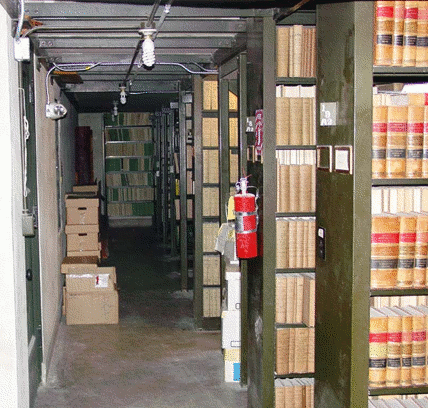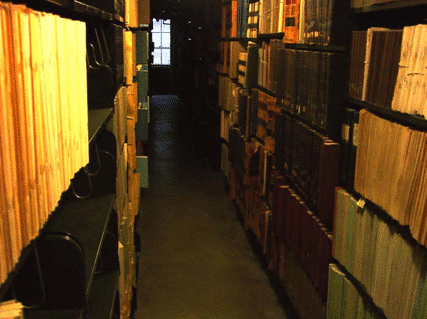

ASSOCIATES (2007, July, v. 14, no. 1) - associates.ucr.edu


Ruby Wilson
SDSU Archives & Special Collections
Hilton M. Briggs Library
Brookings, South Dakota
ruby.wilson@sdstate.edu
It started out as a way to escape the heat. In June, when my boss suggested I spend half a day over at our archives storage building while the air conditioning unit at our library was being repaired, it sounded like a great idea. “Oh by the way, you could inventory those old government documents that are being stored in the basement over there, while you cool off,” he casually mentioned. Since my prior position was government documents technician, it didn’t seem like an unreasonable request. That is how I began my odyssey in the “dungeon”, as I have affectionately begun to call it.
The work began routinely enough, with Library of Congress publications dating from 1901. Within the first week, I made my first interesting discovery, a book about the origin of the swastika. It was published by the Smithsonian Institution in 1896, long before the second World War when the symbol achieved world-wide notoriety representing the Nazi party. Prior to finding this book, I knew that the swastika was an ancient symbol that had been used by American Indians for centuries. Scanning the first few pages, I learned that it was probably one of the oldest symbols used by human civilizations. According to this document, the name derives from the Sanskrit language and signifies “happiness, pleasure, good luck.”
 Next, I sped through shelves of periodical publications such as the Department of Education’s Good References, and Index Catalogs from the Surgeon General’s Office. I’d have to open and scan the books periodically, because the government agency that published the series would often change. Much like today, many of what I would consider to be civilian agencies would be re-channeled under security or war departments during wartime, eventually returning to a non-defense agency some years after the end of the war.
Next, I sped through shelves of periodical publications such as the Department of Education’s Good References, and Index Catalogs from the Surgeon General’s Office. I’d have to open and scan the books periodically, because the government agency that published the series would often change. Much like today, many of what I would consider to be civilian agencies would be re-channeled under security or war departments during wartime, eventually returning to a non-defense agency some years after the end of the war.
For example, the Bureau of Education started out under the Department of the Interior in the earliest publications that I inventoried (1906 Bureau of Education bulletins). In 1940 the publications originated in the Federal Security Agency, and continued that way through 1952, after which time it changed again to come under the jurisdiction of the Department of Health, Education and Welfare.
Another example is the Notices of Judgment of the Food, Drug and Insecticide Administration. This publication started out in 1927 being published by the Department of Agriculture. In 1941 the name changed to the Food and Drug Administration, and became absorbed by the Federal Security Agency until 1953, when its lead agency changed to the Department of Health, Education and Welfare.
In addition to obvious patterns like the originating agency of certain documents, there were interesting patterns in serials that were more subtle, such as the Department of Education bulletins and circulars. I noticed that during relatively peaceful times like the late 1930’s, there were numerous publications in one year, bound into an average of seven volumes or so. However, the publications in 1942 and 1943 shared one small volume. During the remainder of the 40’s and early 50’s, the circulars and bulletins consisted of one bound volume per year. After that, the volume of publications per year gradually increased to 20 or more bound volumes in the early to mid 1960’s. It seemed a tangible indication, that during times of war, resources and money may be taken away from civilian endeavors and channeled into the war effort.
Moving along down the range I encountered the Gazetteers, volumes of geographic place names for the countries of the world. This publication contains latitude and longitude designations for populated areas, geographical features such as canyons, mountains and hills, and also man-made structures such as wells, walls and ditches. I was moving right along, inventorying one or two volumes for most of the countries, like Madagascar and Tanzania. Then I came to Gazetteer # 42, with seven volumes in two editions in 1959 and 1970, for a total of 14 volumes. I wondered what was going on, until I saw that the volumes were for the Soviet Union. It made a lot of sense, in light of the Cold War that was taking place during those decades. Other large and populated countries like China and India had one or two volumes, at a maximum.
 The last range that I’m working on consists of 57 shelves of congressional hearings dating from 1962 to 1972, a total of 4087 publications. I was sure that these last publications would be a marathon of boring, tedious work. To my surprise, however, I started to notice very interesting titles on some of these documents. The first one that caught my eye was Communist Activities in the Minneapolis, Minn. Area, hearings before the House Committee on Un-American Activities, published in 1964. Right next door was, Protecting Postal Patrons from Obscene and Obnoxious Mail and Communist Propaganda. After encountering those two, I started to pay more attention to the dusty, curled volumes that I was handling.
The last range that I’m working on consists of 57 shelves of congressional hearings dating from 1962 to 1972, a total of 4087 publications. I was sure that these last publications would be a marathon of boring, tedious work. To my surprise, however, I started to notice very interesting titles on some of these documents. The first one that caught my eye was Communist Activities in the Minneapolis, Minn. Area, hearings before the House Committee on Un-American Activities, published in 1964. Right next door was, Protecting Postal Patrons from Obscene and Obnoxious Mail and Communist Propaganda. After encountering those two, I started to pay more attention to the dusty, curled volumes that I was handling.
After a few more years’ worth of published hearings I found Campus Unrest, a hearing before the Committee on Education and Labor that sought to terminate assistance to campuses where disruptions occur, and would have created a Federal Higher Education Mediation and Conciliation Service. The hearing was held in 1969, during the height of the Vietnam protests on campuses. Not surprisingly, I eventually encountered U.S.-Vietnam Relations 1945-1967, also known as the Pentagon Papers. Immediately following, was Extension of the Draft and Bill Related to the Voluntary Force Concept and Authorization of Strength Levels, published by the House Committee on Armed Services.
Among all of these hearings, were other notable ones on civil rights issues, discrimination against women, and desegregation of public schools. I was struck by how much turmoil and change marked this decade of our country’s history. I imagine if we looked at any other decade in our past, we would be surprised by how much change we’ve struggled through. On the other hand, we may be saddened that we seem to keep making some of the same mistakes over and over again.
I am nearing the end of this interesting adventure. While I won’t be sad to get out of the gloomy, dusty environment, the small discoveries along the way were enlightening and engaging. How else would I have known about the Battle of the Cowpens (Revolutionary War), the Office of Facts & Figures (my favorite government department), or How Liberal Clergymen Aid the Revolutionists (published in 1970)?
History was the most boring class that I had to take in high school. I just couldn’t keep all those names and dates straight. Events in the present, and those that might come in the future, were much more interesting to me. Later, when I told people that I work in government documents in the library, their eyes would glaze over. Now I find that the two, history and government documents, are much more interesting than I would have imagined. Now that my own decades since high school are history, it’s clear that books and classes can’t possibly encompass the whole of human experience that comprise our story. The older government documents become, the more they have to say about the lives and times of their creators.
Photos by Stephen Van Buren.
REFERENCES:
Church League of America. How Liberal Clergymen Aid the Revolutionists: A Documented Report. Illinois: Church League of America, 1970.
U.S. Department of Agriculture, Food, Drug and Insecticide Administration. Notices of Judgement. Washington: U.S. Government Printing Office, 1927-1965.
U.S. Department of the Interior, Bureau of Education. Bulletin. Washington: U.S. Government Printing Office, 1907-1961.
U.S. Department of the Interior. Gazetteer. Washington: U.S. Government Printing Office, 1955-1977.
U.S. Department of the Interior, Office of Education. Good References. Washington: U.S. Government Printing Office, 1931-1945.
U.S. House of Representatives. Committee on Armed Services. U.S.-Vietnam Relations 1945-1967, 92nd Congress, 1st Session. Washington: U.S. Government Printing Office, 1971. (Y 4.Ar 5/2:V67/3/945-67/bk.1-12).
U.S. House of Representatives, Committee on Armed Services. Extension of the Draft and Bills Related to the Voluntary Force Concept and Authorization of Strength Levels Hearing, 92nd Congress, 1st Session. Washington: U.S. Government Printing Office, 1971. (Y 4.Ar 5/2a:971-72).
U.S. House of Representatives. Committee on Education and Labor. Campus Unrest Hearing, 16 June 1969, 91st Congress, 1st Session. Washington: U.S. Government Printing Office, 1969. (Y 4.Ed8/1:C15).
U.S. House of Representatives. Committee on Post Office and Civil Service. Protecting Postal Patrons From Obscene & Obnoxious Mail & Communist Propaganda Hearing, 16 April 1964, 88th Congress, 2nd Session. Washington: U.S. Government Printing Office, 1964. (Y 4.P84/10:067/3/pt.2).
U.S. House of Representatives. Committee on Un-American Activities. Communist Activities in the Minneapolis, Minn. Area Hearing, 24, 25, 26 June 1964, 88th Congress, 2nd Session. Washington: U.S. Government Printing Office, 1964. (Y 4.Un1/2:M66).
U.S. Smithsonian Institution, Thomas Wilson. The Swastika. Washington: U.S. Government Printing Office, 1896, page 768.
U.S. Surgeon-General’s Office. Index Catalogs. Washington: U.S. Government Printing Office, 1896-1961.